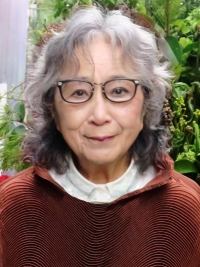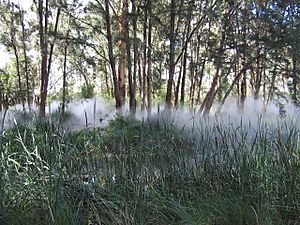Fujiko Nakaya facts for kids
Quick facts for kids
Fujiko Nakaya
|
|
|---|---|

Nakaya's Fog Sculpture #08025 "F.O.G.," Guggenheim Museum Bilbao, Spain
|
|
| Born | 15 May 1933 |
| Nationality | Japanese |
Fujiko Nakaya (中谷 芙二子, Nakaya Fujiko, born 15 May 1933) is a Japanese artist. She is famous for her unique "fog sculptures." She also helped develop video art in Japan and was part of a group called Experiments in Art and Technology (E.A.T.).
Contents
Early Life and Learning
Fujiko Nakaya was born in Sapporo, Japan, in 1933. Her father, Ukichiro Nakaya, was a scientist. He was the first person to create artificial snowflakes! He also made documentary films and was a talented artist.
His scientific ideas and art greatly influenced Fujiko's own art. Fujiko went to high school in Tokyo. Then, she moved to the United States to study at Northwestern University. She earned her degree in 1957. After that, she studied painting in Paris and Madrid until 1959.
Her Artistic Journey
After studying in Europe, Nakaya returned to Japan in 1960. She showed her oil paintings in Chicago with her father. Her first solo art show was in Tokyo in 1962.
Art and Technology Experiments
Nakaya became well-known through her work with Experiments in Art and Technology (E.A.T.). This American art group started in 1967. Nakaya first helped E.A.T. in 1966. She officially joined the group in 1969 as their representative in Tokyo.
Billy Klüver, one of E.A.T.'s founders, invited her to create a fog sculpture. This was for the Pepsi Pavilion at Expo '70 in Osaka, Japan. Nakaya wanted to use water-based fog, not chemicals. She worked with engineer Thomas Mee to design the world's first water-based fog sculpture.
They studied how nature would affect the fog. They tested different devices and wind patterns. The fog sculpture became a highlight of the Pepsi Pavilion. Nakaya and Mee even got patents for their fog system. Since then, Nakaya has created many fog installations worldwide. These include works at the Australian National Gallery and the Guggenheim Museum Bilbao.
After Expo '70, Nakaya continued with E.A.T. in Tokyo. They worked on a project called Utopia Q&A, 1981. This project connected terminals in Tokyo, New York, Stockholm, and Ahmedabad. People sent messages predicting what the world would be like in 1981. Famous Japanese figures, like manga artist Osamu Tezuka, joined in from Tokyo.
Video Art and Galleries
Since the 1970s, Nakaya has been a key figure in Japanese video art. She helped connect artists in North America and Japan. She worked with Yamaguchi Katsuhiro to organize Japan's first video art exhibition in 1972.
She was a main member of the Video Hiroba group. This group formed during that first exhibition. Nakaya created video works and helped promote Japanese artists abroad. She translated important texts about video art into Japanese. She also helped organize a Japanese video art exhibition at the Museum of Modern Art in New York in 1979.
In 1980, Nakaya opened Video Gallery SCAN in Harajuku, Japan. This was Japan's first video art gallery. It held competitions for new artists. It also featured solo shows by artists like Bill Viola and Nam June Paik. The gallery organized the Japan International Video Television Festival. These festivals showed works by many artists, including Shigeko Kubota and Marina Abramović. They even experimented with live satellite broadcasts.
Amazing Fog Sculptures
Nakaya's fog works have been her main focus since Video Gallery SCAN closed in 1992. She explained that she doesn't directly create images with fog. Instead, the fog reacts to the weather. It helps people see nature's stories and information more clearly.
Art critic Kenjiro Okazaki has written a lot about Nakaya's fog works. He connects them to her father's scientific work. Her father used photos and films to record snow and weather. Okazaki says Fujiko's interest in fog and video is like her father's interest in documenting nature. Both artists focused on how things change and happen, rather than just the final object.
Nakaya often works with other artists on her fog projects. These include video artist Bill Viola and musician Ryuichi Sakamoto. In 1992, she helped create a playground in Tokyo. Dense fog covers visitors twice an hour there. Visitors feel lost as the fog appears and found again as it disappears. This work reminds people about nature and the cycle of life.
In 2002, Nakaya advised architects Diller Scofidio + Renfro on their "Blur Building." This building was made for the Swiss Expo 2002. It was a building made entirely of fog!
Nakaya has received many awards for her work. These include the Australian Cultural Award and the Laser d’Or. In 2018, she received the Praemium Imperiale award in sculpture. This is a very important award from the Japan Art Association. Her first big art show was in Japan in 2018. The first show outside Japan was in Munich, Germany, in 2022.
Notable Artworks
- 1970: Fog Sculpture "PEPSI PAVILION," Expo '70, Osaka
- 1972: Friends of Minamata Victims—Video Diary
- 1973: Old People's Wisdom—Cultural DNA, installation at Sony Building, Tokyo
- 1974: Standing an Egg, interactive video installation, Tokyo Metropolitan Art Museum, Tokyo
- 1976: Fog Sculpture #94768: Earth Talk, The 2nd Biennale of Sydney
- 1980: Opal Loop/Cloud Installation #72503, for Trisha Brown Dance Company, New York
- 1980: Fog Sculpture: Kawaji, Festival of Light, Sound and Fog, Tochigi (with Bill Viola)
- 1983: Fog Sculpture #94925: Foggy Wake in a Desert: An Ecosphere, National Gallery of Australia, Canberra (a permanent artwork)
- 1988: Fog Sculpture: Skyline, Jardin de l'eau, Parc de la Villette, Paris
- 1992: Foggy Forest, Children's Park, Showa Memorial Park, Tachikawa (Tokyo)
- 1998: Fog Sculpture #08025: F.O.G., Guggenheim Museum Bilbao, Spain (part of the museum's collection)
- 2001: IRIS, Fog Sculpture with Shiro Takatani in Valencia Harbour, Spain
- 2013: Fog Bridge #72494, Exploratorium, San Francisco
- 2014: Veil, The Glass House, New Canaan, Connecticut
- 2017: Pathfinder #18700 Oslo, Ekebergparken, Oslo, Norway
- 2018: "Fog x FLO" includes five installations along Fredrick Law Olmsted's Emerald Necklace in Boston.
- 2022: "Munich Fog (Wave), #10865/I" and "Munich Fog (Fogfall) #10865/II" at Haus der Kunst in Munich, Germany.
Awards and Recognition
Fujiko Nakaya has received many honors for her amazing work:
- 1976: Australian Cultural Award
- 1990: Laser d'Or, Locarno Video Festival
- 1993: Yoshida Isoya Special Award
- 2008: Media Arts Festival, Special Achievement Prize
- 2017: Commandeur, Ordre des Arts et des Lettres, France (a high honor in French culture)
- 2018: Praemium Imperiale Award in Sculpture, from the Japan Art Association
- 2023: Wolf Prize in Arts
Other Interesting Facts
- From 1979 to 1998, Nakaya taught at Nihon University.
- She holds a patent for her "System/apparatus for making a cloud sculpture from water-fog."
- The author Dan Brown mentioned Nakaya's fog sculpture in his 2017 novel Origin (Brown novel). His character Robert Langdon visits the Guggenheim Museum in Bilbao and sees her constantly changing fog sculpture.
See also
 In Spanish: Fujiko Nakaya para niños
In Spanish: Fujiko Nakaya para niños


